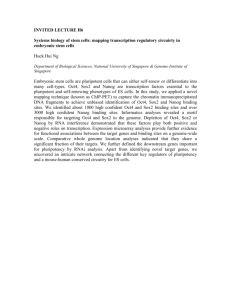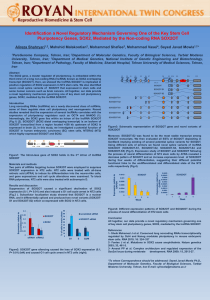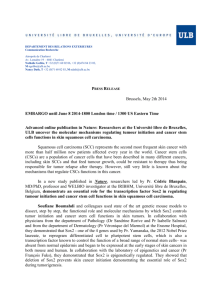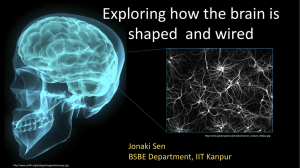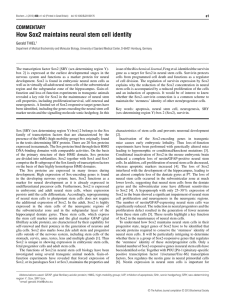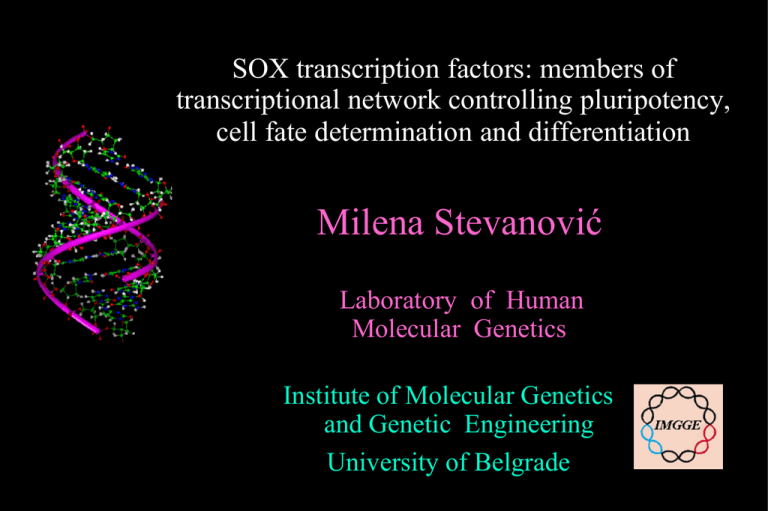
SOX transcription factors: members of
transcriptional network controlling pluripotency,
cell fate determination and differentiation
Milena Stevanović
Laboratory of Human
Molecular Genetics
Institute of Molecular Genetics
and Genetic Engineering
University of Belgrade
SOX (SRY-related HMG-box) trancription factors
•Encoded by SOX genes: one of the earliest classes of genes expressed during
embryonic development
•Key players in the regulation of embryogenesis and development
•Involved in maintenance of pluripotency, cell fate determination, differentiation
and proliferation in numerous developmental processes
SOXA
SRY
SOXB
SOX1
SOX2
SOX3
SOXB1
SOXB2
SOXC
SOXD
SOX14
SOX21
SOXF
SOXG
SOXH
Sex determination
13q34
Eye development; neurogenesis
3q26.3-q27
Xq26.3
Maintenance of pluripotency; neurogenesis; eye development
Neurogenesis; eye development; pituitary development
13q31-q32
Neurogenesis
Neurogenesis
SOX4
SOX11
SOX12
6p22.3
Cardiogenesis; neurogenesis; lymphopoiesis; pancreas formation
2p25
Cardiogenesis; neurogenesis
20p13
Unknown
SOX5
SOX6
SOX13
12p12.1
Skeletogenesis; neural crest development; gliogenesis
11p15.3
Skeletogenesis; gliogenesis; cardiac conduction; erythropoiesis
Lymphopoiesis
SOX8
SOXE
Yp11.3
SOX9
3q22-q23
1q32
16pter-p13.3
17q24.3q25.1
Gliogenesis; osteogenesis; neural crest development
Chondrogenesis; sex determination; neural crest dev.; gliogenesis;
cardiogenesis; pancreas formation
SOX10
22q13
Neural crest: formation; inner ear formation
SOX7
SOX17
SOX18
8p22
Cardiogenesis
8q11.23
Endoderm formation; angiogenesis
20q13.33
Angiogenesis; cardiogenesis; hair follicle development
SOX15
17p13
Skeletal muscle regeneration
SOX30
5q33
Unknown
Transcription activators, repressors, with no trans-activating domains
SOXB1 transcription factors (SOX1, SOX2 and SOX3)
• The expression in vertebrates is associated with the acquisition of neural progenitor identity
and is then maintained in the entire progenitor population of the developing and adult nervous
system.
• Sox1–3 genes promote self-renewal and maintain neural progenitor in an undifferentiated
state
• During nervous system development SOX1, SOX2 and SOX3 control many different
processes, including maintenance of pluripotency, specification and terminal differentiation.
They continue to be expressed and to maintain neural progenitors in the adult brain,
controlling adult neurogenesis.
SOX2 is a major stemness factor
• SOX2 is one of the “magical four” crucial transcription factors capable of cooperating
to reprogram differentiated cells into an induced pluripotent stem cell (iPS)
• Other Sox family members have been found to work as well in the induction process
with decreased efficiency :
– Sox1 yields iPS cells with a similar efficiency as Sox2
– Sox3, Sox15, and Sox18 also generate iPS cells, although with decreased efficiency.
Model system: the embryonal carcinoma cell line
NT2/D1
• Cells resemble early embryonal stem (ES) cells in morphology, antigen expression
patterns, biochemistry, developmental potential, and gene regulation.
• In the presence of retinoic acid (RA), NT2/D1 cells differentiate along the neuronal
lineage, providing an in vitro model system for studying human genes that promote and
regulate neural differentiation.
Specific research goals
• To study the structure and transcriptional regulation of human SOX genes
expression
– SOX2, SOX3 , SOX14 and SOX18
• To detect control elements, transcription factors and signaling pathways
involved in regulation of SOX genes expression
• To manipulate the level of SOXB genes expression by gain-/loss-offunction studies
• To study the effects of modulation of SOX genes expression on neural
differentiation
Neural differentitation of SOX2 over-expressing NT2/D1 clones
G3 without RA
NT2/D1 without RA
NT2-Neurons
G3-Neurons
Increased SOX2 expression in
NT2/D1 cell clone G3:
•Modulates expression of key
pluripotency genes
•Results in higher proliferation rate
•
•Do not prevent the cells to enter into
RA-dependent neural differentiation
even in the presence of elevated
SOX2 expression
DAPI
SOX2
MAP2
•Differentiate into fewer neuron-like
MAP2 positive cells
• Prof. Roberto Mantovani: Dipartimento di Scienze Biomolecolari e
Biotecnologie, Università degli Studi di Milano
• Role of Transcription Factors NF-Y in stem cells biology
• NF-Y is a trimeric TF that regulates directly the expression of human SOX2, SOX3 ,
SOX14 and SOX18 genes
• Specific goals:
– To investigate the mechanistic role of NF-YA in the expansion of the stem cells
compartment(s), including mouse ES cells and human NT2/D1
– To study specifically the NF-Y/Sox2 interplay and its role in proliferation and differentiation at
the molecular and genomic level.
Laboratory of Human Molecular Genetics
• Dr Danijela DRAKULIĆ, PhD
• Isidora PETROVIĆ, MsC
• Dr Andrijana Klajn, PhD
• Milena MILIVOJEVIĆ, MsC
• Dr Marija MOJSIN, PhD
• Aleksandar KRSTIĆ, MsC
• Dr Nataša KOVAČEVIĆ-GRUJIČIĆ, PhD
• Dr Jelena POPOVIĆ, PhD

